FAQs
Elevating Early Childhood by expanding high quality choices and supporting families.
Why is quality early childhood education important?
Creating equal opportunities for all children to learn and grow in their early years – regardless of race, gender or socioeconomic background – is vital to Lincoln’s prosperity. Access to high quality early childhood experiences enables children to be kindergarten-ready and to develop into successful community citizens. In Lincoln, 78% of children live in households where all parents are in the workforce. High-quality child care helps children to develop the range of skills necessary for future life success. Conversely, low-quality early environments can lead to deficits in children’s development.
What is the cost of child care?
Child care is very expensive. In fact, Nebraska is one of the least affordable states in the U.S. for child care. The annual cost of $12,480 for family child care for an infant would take up almost 15% of income for a median income two parent family. Nebraska ranks least affordable in the nation for a range of child care types.
How can Lincoln parents access affordable quality child care?
Providers of quality care have openings to provide child care for families who are in low-income situations. Parents may receive help to pay for child care for infants, toddlers and preschoolers from two main sources:
- Child Care Subsidy through the Department of Health and Human Services
- Tuition assistance programs through individual child care providers
Unfortunately, many families fall in the gap between qualifying for Child Care Subsidy and being able to afford to pay for high-quality early childhood care. Tuition assistance through Lincoln Littles Early Learning Fund will help fill this gap. Working parents are often forced to make the difficult decision of accepting a raise and losing all of their child care subsidy or keeping their lower wage job so they can keep their child in a quality setting.
What is child care subsidy and who can access it?
The child care subsidy program helps low-income Nebraskans work, find a job or pursue education by subsidizing the cost of child care. Currently, initial eligibility of the program is limited to those at or below 130% of the federal poverty level (FPL), which is at or below 37% state median income. Note that Nebraska’s program eligibility was set much higher in the past. Families must renew their eligibility every 12 months.
Statistics
- 42% of Lincoln families with children under age 6 live in poverty* or near poverty
- 3,665 children under age 5 in Lincoln live in families that fall below the poverty* threshold
- 78% of Lincoln’s children under 6 have all parents in the workforce
- Lincoln parents at all income levels report expense as the biggest challenge to accessing high-quality care
- In Lincoln, the average cost of childcare ($10,000-$14,500 per year) is more than the average cost of resident tuition for a year of public college ($8,978) (most recent 2017 data)
- Most children under 5 who live in families below the poverty* threshold live with single moms (54%), followed by married couples (36%), and single dads (10%)
- Lincoln Littles funding can support working families with a portion of tuition if they earn under 80% Area Median Income (AMI).
